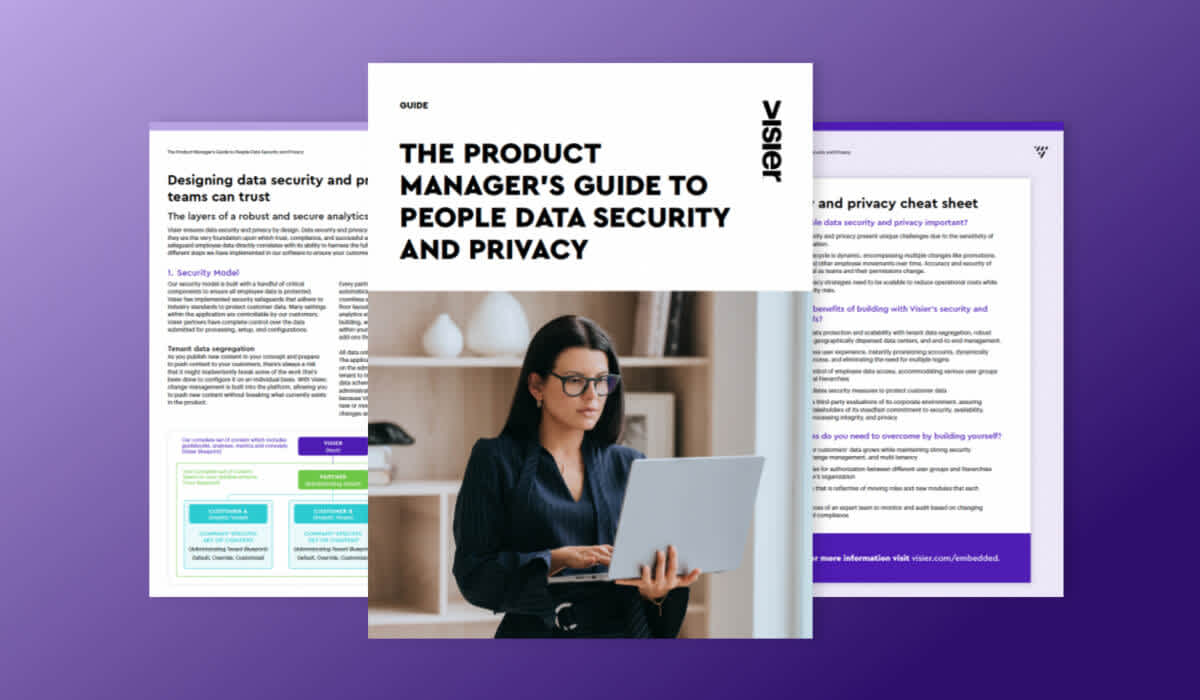6 Must-Have Employee Engagement Metrics for HR Software
Engagement data is more valuable with context. These six metrics can help your customers deliver the right insights to improve employee engagement. Find out more.

Highly engaged employees are more productive, more committed to the organization, and more likely to put in the extra effort that makes the difference between “good” and “exceptional” outcomes. So, it’s no surprise that HR software vendors are facing increasing demands for easy-to-use, actionable ways to stay on top of employee engagement.
Measuring employee engagement is more complex than tracking survey results. To get the full picture, your users must look at how employee engagement interacts with other key metrics in the organization.
HR metrics like turnover, retention, and customer happiness work together to provide a more complete picture of employee engagement within an organization. By providing these six metrics, your customers will be able to track, measure, and act on employee engagement quickly and easily.
1. Voluntary turnover rate
Voluntary turnover is a strong indicator of lower employee engagement since employees in this group deliberately choose to leave the organization. When employees feel supported and challenged in their work and see a career path in their organization, they’re less likely to leave. This makes the voluntary turnover rate an important place to start.
To get more context, users need the ability to analyze the data in detail. When they can zoom in or slice-and-dice the data, they can look more closely at who is leaving and when, and dig into which departments have the most exits. By comparing the voluntary turnover rate with the engagement rate among key groups, users can see how closely correlated the two metrics are throughout the organization.
2. Employee retention rate
The voluntary turnover rate accounts for employees leaving the organization, whereas the employee retention rate looks at what percentage of employees stay with the organization. High retention rates often indicate high engagement, but being able to investigate this metric more closely by employee tenure groups, departments, and teams can help users identify trends and areas for improvement.
For example, suppose less tenured groups have lower engagement rates. With the right data, an HRBP could implement an employee recognition program to help motivate employees to increase engagement and satisfaction, which can substantially impact the business. A Workhuman and Gallup study found that by integrating recognition into company culture, a 10,000-person organization with an already engaged workforce can save up to $16.1 million annually due to reduced employee turnover.
3. Absenteeism
The absenteeism rate is measured as the number of absent days out of the total number of working days in a specific time period. Absenteeism can serve as an indicator of current employee engagement, and a warning signal of future potential employee dissatisfaction. High absenteeism correlates with low employee engagement, whether it stems from bad working conditions, poor leadership, or a lack of work-life balance.
Since increased absenteeism means greater workloads for other employees, it can be a powerful indicator that employee satisfaction and engagement are trending down. When teams are highly engaged in their work, businesses can experience a drop in absenteeism by 41%.
4. Employee net promoter score (eNPS)
Employee NPS is one of the most common ways to track employee engagement. It shows the percentage difference between promotion and detracting employees within a specific population. The positive and negative scores are derived from the question "How likely are you to recommend our organization as a place to work?" The answer scale is 1 out of 10. People scoring 9 or 10 are promoters. People scoring between 0-6 are detractors. The rest are considered passive.
On its own, eNPS provides a valuable benchmark or baseline to track overall employee engagement, but without context, it lacks the nuance needed to make fuller investigations. To make it more dynamic, users should be able to compare it to other metrics such as retention, and dive deeper into key groups.
5. ROI of employee engagement
Organizations can use HR metrics like employee productivity rates, turnover costs, customer satisfaction scores, and absenteeism rates to determine the ROI of employee engagement programs. With access to business data and HR metrics in one place, HR teams can even look at the overall profitability before and after implementing engagement initiatives.
A Gallup study found businesses with highly engaged employees achieve a 23% difference in profitability compared to lower engaged business units. Willis Towers Watson reports that companies with engaged employees can benefit from a 19% increase in operating income—and when engagement is lower, operating income decreases by 30%.
Each organization has unique goals and a specific path to ROI, so users need the ability to easily identify their unique key metrics and track them over time. By measuring and comparing these metrics, companies can determine the financial impact of their employee engagement strategies.
6. Customer satisfaction
Engaged employees are more attuned to customer needs, more productive, and more deeply invested in their work. These behaviors make it more likely that engaged employees will put in extra effort to deliver high-quality service that removes friction points and keeps customers happy. According to PwC, companies that provide superior experiences to both their consumers and employees can charge a premium of as much as 16% for their products and services.
Tracking customer satisfaction alongside other key metrics like turnover and absenteeism gives users a valuable understanding of how employee engagement is ultimately tied to business results.
Embed analytics into your engagement software in the daily flow of work
Tracking employee engagement is difficult, especially since engagement data is often siloed away from HRIS and business data. Measuring employee engagement also requires using both quantitative and qualitative data, which needs to be parsed differently for analysis. This makes it incredibly hard for HR leaders and HRBPs to find the right data and insights to answer key business questions quickly and accurately.
Engagement data is more valuable with context. These six key metrics can help your customers do more with their engagement data and make real progress on improving employee engagement. Visier Talent Management Analytics has prebuilt analyses to guide users with data-driven insights that enable them to plan ahead and determine the best course of action for their people.
Ready to learn more?
Visier Embedded Analytics™ applications are purpose-built with a people data focus and allow you to deliver proven solutions in a few short months, helping you and your users win together. To learn more about adding Visier’s powerful analytics—including our talent management and engagement application—here.

Embed people analytics into your app
To make sense of the changing world of work, businesses of all sizes need analytics. There are typically three paths software vendors can take based on their goals—read about them here.
Contextual analytics delivers answers directly in the platforms people already use, bringing data and insights into the ways they already work. Learn how to combine the power of contextual and embedded analytics here.
GenAI can be used throughout the employee lifecycle to increase productivity and support strategic workforce planning. Get the scoop.
Embedded analytics are analytics capabilities that are integrated within another application—and the value goes far beyond just convenience. Here's what you need to know.


